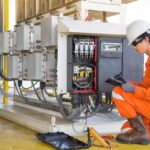No one wants to have to contend with an HVAC system that conks out on you on the hottest day of summer. Regular maintenance and care help keep that from happening, and on top of the list of tasks is regularly replacing the air filter.
But when you shop for a replacement filter, the shelves are full of options and it’s easy to be overwhelmed by your choices. One easy way to narrow down your choices is by looking at the MERV rating listed on the package.
Let’s take a look at this important number and the appropriate MERV ratings for HVAC systems like yours.
What Is a MERV Rating?
MERV stands for Minimum Efficiency Reporting Values, which tells you the filter’s ability to capture particles in the air.
The system was developed by ASHRAE and is the industry standard to test the overall effectiveness of a filter and sets the MERV ratings for air conditioners.
MERV specifically looks at particles between 0.3 and 10 microns and the numbers run from one to 20. The higher the number, the finer the filtration is and the more contaminants the filter will catch.
Filters are tested against a variety of particles to determine the MERV rating, including:
- Pollen
- Dust mites
- Mold spores
- Dust
- Pet dander
- Bacteria
- Tobacco smoke
The number is listed right on the filter packaging for most filters, although there are a couple of brands that have their own filter ratings. The one you’re most likely to run across is from 3M, which uses its Microparticle Performance Rating or MPR for its Filtrete brand.
The filter ratings allow you to compare performance across different types.
Choosing a MERV Rating
Most home HVAC systems work well with filters rated between seven and 12, although you will see recommendations for at least MERV 13. Ratings of 13 and higher are typically found in hospitals, labs, and surgery settings, which makes them more than most homes would need.
You should check to find out what MERV for ACs is listed for your specific system to ensure you don’t strain the system.
A higher rating means smaller pores for air to get through, which can make the system use more energy. If you reduce the airflow too much, you can damage the fan of your system, so check your manual or with your HVAC professional to make sure you have the correct rating for your system.
When to Change Your Air Filter
Changing out your air filter is a key piece of maintenance for your HVAC and one that can avoid the need for AC repair in the middle of summer.
The higher the MERV rating, the more frequently you will need to change the filter. These deliver a more restricted airflow that can cause your system to work inefficiently over time.
They should be changed at least every three months depending on your home’s environment.
Choose Your Filter
Filter technology has improved greatly in recent years to scrub even tiny particles from the air.
Now that you know more about a MERV rating and how to choose the right one for your system, you can shop for an air filter with confidence. Keep in mind the HVAC MERV rating guide laid out in this article, and you should be able to pick the right rating level for your home environment.
Check out our other articles for more tips for improving and taking care of your house as well as buying guides for the things you need around the home.




